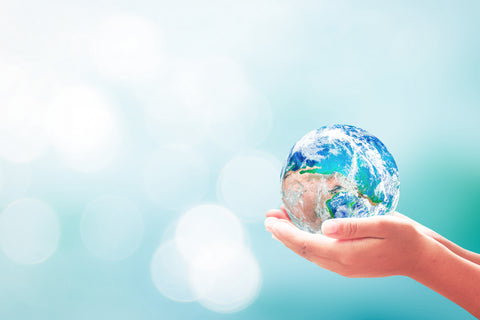Today, 1 billion people around the planet in more than 193 countries are coordinating activities promoting planet awareness for Earth Day, 22 April 2021. Lark & Berry want to do our part to join in!
But you might be wondering, as we were - how did Earth Day come about and find its home on the calendar at 22nd April? How do people around the world "celebrate" this day? What kind of measurable mark can Earth Day make for the planet in a bid to help save it?
Read on to find out...

If you didn't know, this year actually marks the 50th anniversary of Earth Day! People say politicians never get anything done, but it turns out we actually have one to thank this time for dubbing 22nd April as Earth Day.
That Wisconsin, USA senator's name was Gaylord Nelson, and in 1970, there were several environmental concerns particularly on his planet wellness 'radar'. They included rising pollution, oil spills and vanishing wildlife. Since the 70's, these problems, and more, have only grown worse. We can definitely thank Nelson for having the foresight to create a day to think of our planet!

22nd April was chosen as the date because it fell between Spring Break and final exams for USA universities. Nelson and other organisers wanted students to be as available as possible to contribute.
For such a new occasion, a remarkable 20 million Americans took part in events and demonstrations on the first Earth Day in 1970. Since that time, Earth Day has been observed on an increasingly wider world scale, and this year will include various observances from over 1 billion people all over the world!

It's tough to specifically recall Earth Day 2020, due to it being during the month when much of the world began observing the strictest lockdowns of the continuing COVID-19 outbreak. But one thing we remember about the 2020 Spring, and you might as well, was some of the magnificent photography and video that came flooding in of cleaner skies and wildlife freely roaming in ways they hadn't for centuries.
That sort of "pause" humanity was forced into taking from our usual commuting and polluting activities left an impression on us here at Lark & Berry. Now, as the world begins to gradually return to normalcy, and as lockdowns lift, we need to be extra mindful of the way we live to ensure the planet survives.

The chiff.com blog has collected three great tips that can help us all take care, even at home, to change our lives in a bid to help the planet this Earth Day - whose official theme this year is "Restore Our Earth."
TIP 1: In the backyard, scope out a good location for a compost pile. Start recycling coffee grounds, egg shells, and scraps of food to decompose and to ultimately enrich your garden for the upcoming growing season.

TIP 2: For a families who quarantine together, take a weekend morning to scour the neighborhood for discarded plastics, cans, and bottles for a personal cleanup project that will help the entire community. If you live in a coastal area, this is especially important in helping to protect ocean wildlife.

TIP 3: Perform a household energy audit. Focus on things like electronic devices like laptops that are left on 24/7 (which accounts for 5-10% of residential energy use per year!) Turn these devices off when not in use and you can save an average $100 on your electric bill annually. Around the house, replace old bulbs with longer-lasting, more energy-efficient ones.

***
Twenty years after the first Earth Day in 1970, the campaign spread internationally. A 1990 U.S. Earth Day demonstration mobilised 200 million people in 141 countries. Today, Earth Day is the largest secular holiday in the world, with more than 500 million people taking part in 174 countries around the world.

Even Google has gotten in on the action, regularly changing their logo to spread awareness of this annual event.

Even with Earth Day now, for decades, being a worldwide phenomenon, we still wonder... is it too late to save the planet? This is a great quote directly from NASA that we feel really sums up how we move forward in these trying environmental times:
"Responding to climate change will involve a two-tier approach: 1) “mitigation” – reducing the flow of greenhouse gases into the atmosphere; and 2) “adaptation” – learning to live with, and adapt to, the climate change that has already been set in motion. The key question is: what will our emissions of carbon dioxide and other pollutants be in the years to come? Recycling and driving more fuel-efficient cars are examples of important behavioral change that will help, but they will not be enough. Because climate change is a truly global, complex problem with economic, social, political and moral ramifications, the solution will require both a globally-coordinated response (such as international policies and agreements between countries, a push to cleaner forms of energy) and local efforts on the city- and regional-level (for example, public transport upgrades, energy efficiency improvements, sustainable city planning, etc.). It’s up to us what happens next."
One thing is for sure...
Our brand has never been so proud to offer only cultured diamonds and stones (also known as lab grown diamonds, grown diamonds and man made diamonds). But if there's one thing that makes us even prouder, it's your support!
Simply by choosing cultured diamonds and stones jewellery, you are choosing the most sustainable luxury jewellery on the planet. You may not even be aware of it, but by supporting cultured, you're also doing your part to support the advancement of the tech used to create our diamonds.
Did you know it's now possible to harness excess C02 in our atmosphere to create cultured diamonds? This isn't the stuff of science fiction - the future is here, NOW!
This is taken from a Vogue article; it details how this process goes:
"There’s currently an excess of 109 billion tons of carbon in the atmosphere, and reducing our emissions isn’t enough to curb global warming. The Intergovernmental Panel on Climate Change says we also need to sequester carbon through natural solutions—like regenerative agriculture and reforestation—and advanced ones, like carbon capture technology. [In that carbon capture process, the process goes like this...] CO2 is scrubbed from the air using direct capture technology; it’s pushed through a filter and converted into methane, the raw hydrocarbon material that will eventually become a diamond; and it’s placed in a reactor, where it will grow atom by atom into a stone. The entire process takes three to four weeks, then the raw diamond is sent to be cut, polished, and set [into jewellery]..."
"...Most importantly, each carat removes approximately 20 tons of carbon out of the sky—a number that’s higher than the average American’s carbon footprint per year..."
Lark & Berry is proud to partner with a lab who is utilising this method to create lab grown diamonds, and like we said, the more people that buy cultured diamonds jewellery, the more demand there will be... and the more ALL labs will eventually transition to using 100% renewable tech.
Let's all take steps in our lives to be more conscious consumers with everything we buy and help save 🌎!



